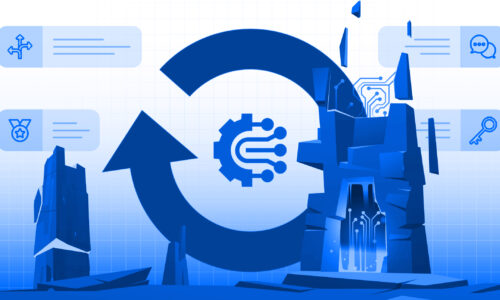The Hidden Key to IT Cost Optimization: How Businesses Use Resource Augmentation to Optimize IT Cost

- 10 June 2024
- Blog
- 0 Comments
What is the PROBLEM?
The Economist shows that data has become a critical resource even claiming it has surpassed oil
in value. However, without skilled and innovative individuals, data’s potential remains untapped.
According to “The Enterprise Guide to Closing the Skills Gap: Strategies for Building and
Maintaining a Skilled Workforce” report by IBM, the availability and quality of skilled human
resources are currently under pressure, and the shortage of skilled workers is projected to
worsen. By 2030, this global talent shortage could exceed 85 million people. The issue lies not in
the lack of workers, but in the lack of the right skills.
A 2018 report on the talent shortage’s impact on employers, highlights that 45% of organizations struggle to find the skills they need, with the percentage rising to 67% for large employers. Almost one-third of employers cite a lack of applicants as the primary reason for unfilled roles, while 20% point to insufficient experience among candidates.
The problem is compounded by the rapid obsolescence of professional skills, especially IT. The half-life of professional skills, once estimated at 10 to 15 years, is now about five years, and even shorter for technical skills. This means that skills acquired today will lose half their value in just five years or less. Historical data reveals an alarming trend: the time required to close skills gaps through traditional training methods is increasing significantly. Globally, the median time to close a capability gap through training was three days in 2014, but it soared to 36 days by 2018, a more than tenfold increase in just four years.
A 2018 report on the talent shortage’s impact on employers, highlights that 45% of organizations struggle to find the skills they need, with the percentage rising to 67% for large employers. Almost one-third of employers cite a lack of applicants as the primary reason for unfilled roles, while 20% point to insufficient experience among candidates.
The problem is compounded by the rapid obsolescence of professional skills, especially IT. The half-life of professional skills, once estimated at 10 to 15 years, is now about five years, and even shorter for technical skills. This means that skills acquired today will lose half their value in just five years or less. Historical data reveals an alarming trend: the time required to close skills gaps through traditional training methods is increasing significantly. Globally, the median time to close a capability gap through training was three days in 2014, but it soared to 36 days by 2018, a more than tenfold increase in just four years.
What is the SOLUTION?
As per the Gartner IT Cost Optimization Decision Framework, key strategies for reducing IT costs
include cloud migration, shared services, application standardization, network consolidation, and
automation of software distribution. These initiatives are prioritized for their potential financial
benefits, positive business impact, and manageable risks. Resource augmentation emerges as the
best solution to implement these strategies effectively, allowing businesses to leverage external
expertise and specialized skills. By supplementing in-house IT teams with external professionals,
companies can achieve significant cost savings, streamline operations, and ensure the successful
execution of these cost optimization initiatives.
What is IT Resource Augmentation?

IT resource augmentation involves supplementing your existing
IT team with external experts or technology solutions. This can
include outsourcing specific IT functions, hiring temporary or
contract expertise staff, or utilizing managed services. The
primary goal is to access specialized skills and technologies
without the overhead costs associated with full-time
employees and extensive in-house infrastructure.
How can IT Resource Augmentation Minimize the COST?
-
- Reduced Labor Costs
Hiring full-time employees entails significant costs, including salaries, benefits, training, and overhead. By augmenting your IT staff with external resources, you can reduce these expenses significantly. According to Gartner, strategic cost optimization initiatives that involve staff augmentation can yield substantial financial benefits with minimal impact on business operations. Maintaining a full-time, specialized IT team can be financially burdensome for smaller businesses. Resource augmentation offers a cost-effective alternative, as you only pay for the expertise you require during specific project phases. This can result in significant cost savings without compromising on quality. - Elimination of Training and Development Expenses
Accessing external IT expertise means you no longer need to invest heavily in training and development for your internal team. This can save businesses thousands of dollars per employee annually. External providers come equipped with the necessary skills and experience, reducing the time and money spent on upskilling your workforce.
According to the 2023 Training Industry Report, the average training expenditure per employee is about $1,000. Large companies, on average, allocate $16.1 million to their training budgets, while midsize companies set aside approximately $1.5 million. Small companies, on the other hand, dedicate an average of $459,177 to training their employees.
According to the above training report, the identified training challenges, including employee retention, lack of subject matter experts, outdated practices, time constraints for learning, and transitioning focus to performance, can be effectively mitigated through resource augmentation. -
- Reduced Overhead Costs
Leveraging IT resource augmentation can serve as a pivotal strategy in cost reduction, particularly through remote staffing solutions. By integrating remote IT resources, companies can substantially cut down on overhead expenses associated with traditional office setups, including expenditures on office space, utilities, and equipment. Remarkably, enabling IT staff to work remotely can lead to annual savings of over $11,000 per employee, as reported by Global Workplace Analytics on Telework Savings Potential. Furthermore, Gartner underscores that remote work, which entails low organizational risk, has the potential to generate substantial cost savings while causing minimal disruption to daily operations.
- Reduced Overhead Costs
- Reduced Labor Costs
Is Sri Lanka the Next Frontier for Resource Augmentation?
Amidst the trend towards diversifying outsourcing destinations, consider Sri Lanka as a viable alternative
for resource augmentation strategies. Beyond traditional outsourcing hubs, Sri Lanka offers a burgeoning
talent pool ripe for exploration. Embracing Sri Lanka as a resource augmentation option opens avenues
to tap into new talent reservoirs and leverage diverse skill sets. With a growing IT industry and a skilled
workforce, Sri Lanka presents a compelling opportunity to enhance your team and drive business growth.
As of 2022, the ICT sector stands tall as the third-highest export revenue earner in Sri Lanka, boasting an impressive $1.5 billion in revenue. Even more impressive is the fact that this growth has been fueled by a workforce of over 150,000 skilled professionals as per SLASSCOM, 2023 report. This sector, with over 90% value addition and high-paying jobs, has undeniably made a substantial impact on the Sri Lankan economy, SL EDB, 2022. According to ICTA 2022 Annual Report, over the past decade, the segment has experienced unprecedented growth, expanding by 300% to become a sought-after hub for Research and Development, Business Process Outsourcing and consultancy services catering to the United States, Australia, and Western Europe. The Sri Lankan IT industry is characterized by its skilled workforce, competitive operational cost structure, English language proficiency, and robust government support to foster sector growth.
As of 2022, the ICT sector stands tall as the third-highest export revenue earner in Sri Lanka, boasting an impressive $1.5 billion in revenue. Even more impressive is the fact that this growth has been fueled by a workforce of over 150,000 skilled professionals as per SLASSCOM, 2023 report. This sector, with over 90% value addition and high-paying jobs, has undeniably made a substantial impact on the Sri Lankan economy, SL EDB, 2022. According to ICTA 2022 Annual Report, over the past decade, the segment has experienced unprecedented growth, expanding by 300% to become a sought-after hub for Research and Development, Business Process Outsourcing and consultancy services catering to the United States, Australia, and Western Europe. The Sri Lankan IT industry is characterized by its skilled workforce, competitive operational cost structure, English language proficiency, and robust government support to foster sector growth.
Conclusion
In conclusion, Resource Augmentation for IT services is a strategic move that can significantly impact
business growth. The benefits of cost efficiency through access to specialized skills, accelerated project
timelines, and risk mitigation, which make it a compelling choice for businesses navigating the competitive
tech landscape.
How X-Venture can help you?
X-Venture stands ready to cater to your IT resource augmentation requirements with precision and
expertise. Our comprehensive suite of services encompasses tailored solutions designed to seamlessly
integrate with your organization’s objectives and workflows. From tapping into Sri Lanka’s burgeoning
talent pool to leveraging remote staffing solutions, X-Venture offers unparalleled support to help you
optimize costs, streamline operations, and achieve sustainable success in today’s dynamic business
landscape. Partner with X-Venture today and unlock the hidden potential of IT resource augmentation for
your organization’s growth journey.
Related Posts

Data-Driven Decision Making: Harnessing API Analytics for Business Insights
- Guest Author
- 8 April 2024
Imagine the frenzy of activity during the Black Friday Cyber Monday (BFCM) period—consumers f ..

Do more with less! Digital Transformation Best Practices.
- Guest Author
- 21 May 2023
Digital Transformation Best Practices. ..


